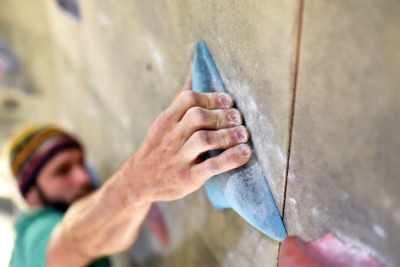You will surprised to learn that when you first start bouldering, finger strength is not really a consideration. On beginner grades, grip strength is more important than finger strength. Finger strength comes into play on smaller, narrow holds that are generally found on more advanced problems.
So how much finger strength is needed for bouldering? To advance in V grades, having the finger strength to hang on a narrow ledge for 5 to 10 seconds will put you in a good place for routes that have crimps and dynamic moves. However, for a beginner to the sport, grip is more relevant than finger strength: someone who can climb a ladder has enough grip strength for the VB and V0 beginner’s grades.
Grip and finger strength serve different purposes in bouldering. Finger strength is important for certain holds, whereas grip strength reflects the general muscle strength in the rest of the body.
Finger Strength Needed for Bouldering
Finger strength comes into its own on crimp holds and dyno moves. Crimps are small ledges that are only wide enough for fingertips. Dynos are dynamic moves that require being airborne for a fraction of a moment, as one jumps between holds.
Beginner problems will generally have very few crimps and dynos. These types of moves are typically found on higher grades.
Is There a Finger Strength Test for Each V Grade?
Unfortunately, no. There are too many variables, such as the types and sizes of holds used on the problem, the subjectivity of grading, and personal ability. However, here are some guidelines that you may find helpful.
Maximum strength is the strength that is achieved when all muscle fibres are engaged. According to Brendan Blanchard of Climbing.com, maximum strength is to be able to hang on to a hold, by the fingers, for 5 to 10 seconds (1).
More specifically, there are no hard-and-fast rules defining that if you can hang on a ledge of x thickness, for x number of seconds, you will be able to do such and such a V grade. Despite this, the following test can help you decide whether it is finger strength or technique that needs work if you have trouble with a certain V grade:
- If you can hang on an 8 mm (3/16 inch) ledge for 5 seconds, you should be able to climb V5 or V6
- If you can hang for more than 5 seconds on the 8 mm (3/16 inch) ledge, but can only do V5 or V6, it is more likely technique that needs improvement rather than finger strength
In other words, if you can do the 5 seconds on the ledge, this should indicate that you can do the V grade, but the reverse is not necessarily true.
For example, some boulderers can do V7 or V9 problems, yet they don’t quite make 5 seconds on an 8 mm ledge. So although it is possible to do higher V grades without the finger strength, if the finger strength is there, you should be able to do more than V5 or V6. If not, then it is probably technique that needs improvement.
How Can I Make My Fingers Stronger?
Here is an interesting fact: fingers do not have muscles. Instead, the tendons that curl the fingers are controlled by the muscles in the hand and forearm. Therefore, improving the strength of the fingers is done by exercising the muscles of the hand and forearm.
Resistance Bands
Experts assert that the best training for bouldering is bouldering itself, since the muscles that get trained are the muscles that are used in the activity. The problem with only doing bouldering is that eventually it will leave the antagonist muscles at a disadvantage.
Bouldering preferentially works the forearm flexors, which close the thumb and fingers into a fist and bend the wrist. This selective use of flexors leaves the extensors, the muscles which straighten the fingers and wrist, in a weaker untrained state.
The imbalance can be fixed with resistance bands like PowerFingers. Working the opposing, extensor muscles with resistance bands will even out the balance of power in the forearm, which in turn will help to prevent injury and allow the forearm as a whole to get stronger.
Climbing Tech Tips demonstrates how this type of device can be used to strengthen both the flexors and extensors of the forearm. Click here to see their informative 2-minute video.
Grip Trainers
Many grip trainers will only increase your strength if you are starting out relatively weak. If you aleady have a strong grip, check them out personally and make sure to get one that offers enough resistance to be useful. Grip trainers like Prohands’ Gripmaster come in several levels of resistance, and the weaker resistance trainers are more suitable for rehabilitation than for strengthening.
Incidentally, exercising one finger will improve not only that finger, but also the overall grip.
This is due to finger inter-dependency, where moving one finger activates muscles that are connected to several fingers.
Squeezing tennis balls, rings and donuts is another option for working on grip and finger strength.
Hangboarding
Hangboarding is an exercise approach that is frequently used in increasing finger strength in climbing and bouldering.
Hangboarding is a full topic on its own, replete with specific recommendations and cautionary tales, so I will only mention here that it is important to start very conservatively with this type of training. With hangboarding as with crimping, it is all too easy to develop a tendon injury that can linger for months.
Having said that, if you’re curious about using hangboards, hanging from a doorframe is an inexpensive way to try it out.
How Long Does It Take to Build Strength?
Building strength takes time. Hoping to see a difference in the first month, while doing one session per week, is not realistic. Expecting a decent increase in grip strength by 4 to 6 months, if bouldering 2 to 3 times per week, is more reasonable.
When training for strength (as opposed to endurance), the best approach is to use heavy resistance for limited repetitions rather than light resistance over many repetitions. To do this when bouldering, push your limits on one or two problems during your session.
How Important Is Grip Strength?
Grip strength is very important because a strong grip is closely associated with a strong and able body, greater overall muscular strength, and less disability as one gets older.
People with a stronger grip have stronger muscles overall. In fact, Pavel Tsatsouline, founder of StrongFirst, affirms that the two most basic things one can do to increase overall strength is strengthening the core and strengthening the grip (3).
Grip Strength in Bouldering
A 2011 study found that a person’s grip strength is strongly correlated to their upper body endurance and to their lower body muscle strength (4). Thus, there is a very real correlation between the strength of one’s grip and the muscular strength and endurance in the rest of the body, both of which will impact performance in bouldering.
In fact, there is a strong correlation between grip strength and general rock climbing ability (5). In bouldering, a good strong grip makes certain moves much easier. Peter Beal in his book Bouldering tells us that dynamic moves are key in advancing up the V grades, and grip strength is important for successful landings on dynos.
However, having a weaker grip does not mean that bouldering is out of the question:
- Most of the holds found in bouldering gyms tend to be used open-handed rather than gripped. Gripping involves closing the fingers and thumb around an object, but most gym holds do not engage the thumb.
- Also, it is not only grip strength, but fitness of the whole body that affects one’s ability in bouldering. This includes a strong core and flexibility in addition to grip strength.
- Beginner grades offer a lot of large holds, such as jugs, that one can grab. These holds offer opportunities to practice and increase grip strength.
Grip Strength in Life
Grip strength starts to decrease after the age of 55, and a weak grip at this age is associated with disability later in life (6). Therefore, having and maintaining a good strong grip is key to staying strong and capable throughout the life span.
Related Questions
How is grip strength tested? You can test your own grip strength with a hand dynamometer. Dynamometers can be hydraulic or digital, and can be set to measure grip strength in pounds or kilograms. They are available on Amazon, and prices vary from $20 to $125. Measurement differences crop up between different dynamometers, even within the same brand. It is therefore recommended to consistently use the same instrument when measuring your improvement.
Does hand shape and size affect grip strength? A 2011 study (7) looked for correlation between grip strength and the shape and size of athlete’s hands. They found that after adjusting for body size, athletes with relatively wider hands and longer fingers had a significantly stronger grip. Curiously, the length of the middle finger by itself was not directly related to grip strength, even though this is the strongest finger for gripping, providing 35% of grip strength (2). The index finger provides 25% of grip strength. Longer forearms and thicker wrists were also associated with a stronger grip.
Closing Tidbits
For introductory information on bouldering problems, click here. For some awesome inspiration, see Jan Hojer training by clicking here.
References
- https://www.climbing.com/skills/learn-to-train-how-to-get-stronger-fingers
- https://www.ncbi.nlm.nih.gov/pubmed/15273677
- https://www.youtube.com/watch?v=b0RLk6hUYds
- https://journals.lww.com/nsca-jscr/Abstract/2011/03001/Hand_Grip_Strength_as_a_Predictor_of_Muscular.156.aspx
- https://www.researchgate.net/publication/319172114_A_Brief_Review_of_Handgrip_Strength_and_Sport_Performance
- https://lib.dr.iastate.edu/extension_families_pubs/38/
- https://www.ncbi.nlm.nih.gov/pmc/articles/PMC3588620/

